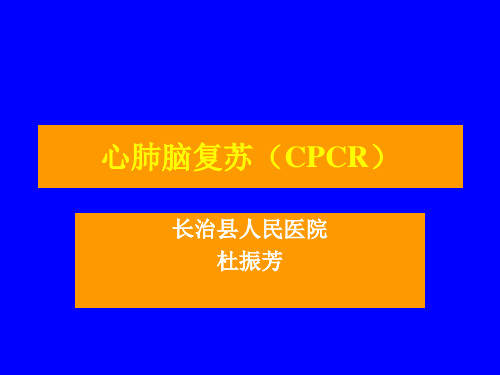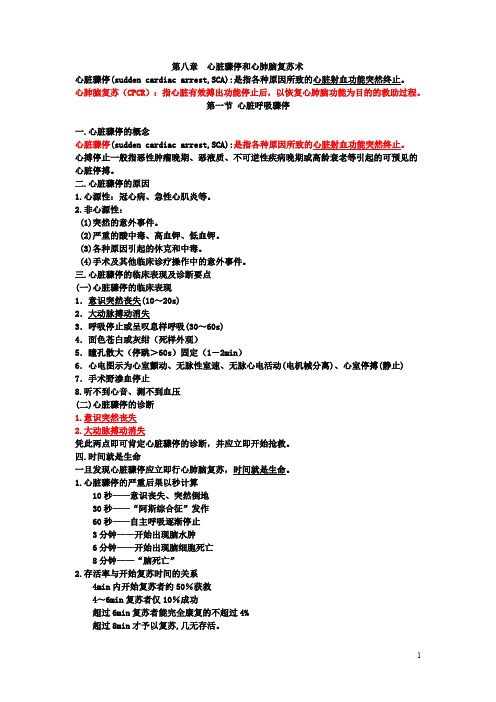外科学:05_心肺脑复苏(CPCR)
外科学课件:心肺脑复苏

•
胸外心脏按压注意事项
(1)肘关节伸直,上肢呈一直线,双肩正对双手,以保 证每次按压的方向与胸骨垂直。用身体的力量,而不是手臂的 力量。
(2)按压幅度至少5 cm,或胸廓直径1/3,最理想的按 压效果是可触及颈或股动脉搏动。
(3)按压频率为至少100次/min ;按压/通气单人、 双人均为30 :2。
胸外心脏按压:病人仰卧在硬板或平
地上,头与心脏处于同一平面。急
救者跪于病人一侧,两臂伸直,双
A
手交叉,手指上翘,以自身重力通
过掌根部垂直按压胸骨下1/2处。
按压与松开时间之比 1:1,下压至
少5 cm ,或胸部前后径1/3,频率
100 次/分。每次按压后,胸廓充
分回弹。
B
单人/双人复苏,心脏 按压 30 次行口对口人 工呼吸 2 次(30:2)
心跳骤停的原因
6H Hypoxia(缺氧)
6T Trauma(外伤)
Hydrogen ion-Acidosis(酸中 Tablets(药物) 毒)
Hypokalema/Hyperkalemia( Tamponade(心包填塞) 低钾/高钾血症)
Hypothermia/Hyperthermia( 低温/体温过高)
心肺复苏(1960年,心脏按压Cardiopulmonary Resuscitation,CPR)
心肺脑复苏(1985年,中枢神经系统功 能恢复,Cardio-pulmonary Cerebral Resuscitation,CPCR)
(2010年AHA复苏指南)
心搏骤停(cardiac arrest)
• 步骤: 1.有效的人工循环(Circulation) 2.保持呼吸道通畅(Airway) 3.有效的人工呼吸(Breathing)
心肺脑复苏简化课件

4. 呼吸改善或出现自主呼吸
5.昏迷变浅,出现各种反射,身体出现无意识 的挣扎动作
影响按压效果的因素:
部位 力量 连续性 频率 按压与放松的时间比
第四十四页,共七十六页。
供氧
氧浓度(Fi02)的计算:
Fi02(%)=21+4×氧流量(L/min)
供氧方法(fāngfǎ):
第四十七页,共七十六页。
复苏 药物 (fù sū)
肾上腺素(Adrenaline)
Ⅰ级
阿托品(Atropine)
Ⅰ~ Ⅱa级
利多卡因(Lidocaine)
Ⅱa级
碳酸氢钠(tàn suān qīnɡ nà)(NaHCO3)
Ⅱb级
多巴胺(Dopamine)
Ⅰ~Ⅱa级
腺苷(Adenosine)
周围静脉通道 方便、不需中断心脏(xīnzàng)按压、并发
症少,但药物峰值低,循环时间较长,应 采用“弹丸式”推注 中央静脉通道
药物作用其效快,可作血流动力学监测
第四十六页,共七十六页。
复苏 药物 (fù sū)
复苏药物的分级: Ⅰ级—肯定(kěndìng)有指征,有助,较安全 Ⅱa级—可用,有效证据多 Ⅱb级—疗效不肯定,无害 Ⅲ—无应用指征,可能有害
# 鼻导管 # 鼻咽插管
# 面罩 # 气管内直接给氧 心肺复苏早期建议给100%纯氧,以后根据患者 情和高况浓选度择F低i0浓26度0%Fi以02上25~30%,中浓度Fi0235~55%
第四十五页,共七十六页。
建立 静脉通道 (jiànlì)
首先着眼点是BLS和电除颤,在此基础上 建立静脉通道并给予复苏药物
第二十一页,共七十六页。
外科学-心肺脑复苏

(二)高级生命支持
3.药物治疗
方法步骤
(2)利多卡因
• 可降低心肌应激性,提高室颤阈值,抑制心肌异位起搏 点,是目前治疗室性心律失常的首选药物。常用量为1~ 1.5mg/kg,缓慢静脉注射(2~3min),必要时可重复应 用,也可以2~4mg/min的速度静脉滴注,但要注意1h内最 大剂量不超过300mg。
• 其中以前三条最为重要
临床诊断
早期识别心跳骤停非常重要
专业人员应5~10秒内判断有无呼吸及大动脉搏动,即使10秒钟内 不能做出判断也应立即复苏,并启动急救医疗服务系统 临床判断应迅速、果断,切忌反复进行血压测量和心音听诊,以免 延误抢救时机
抢救过程
基本生命支持 高级生命支持 复苏后治疗
方法步骤
(一)基本生命支持
方法步骤
人工呼吸的先决条件
仰头提颏 法(最简单
有效)
仰头抬 颈法
开放 气道
托下颌法
(颈椎或脊 柱有损伤者)
(一)基本生命支持
方法步骤
人工呼吸(现场常用口对口、口对口鼻方法) 1.徒手人工呼吸:一手小鱼际置于患者前额并下压使其头部后仰,拇 指及食指捏闭患者鼻孔,另一手抬颈或提起下颌,用嘴唇完全包住患者 口(鼻),平静呼吸状态下用力吹入,吹气时间不小于1秒。
心肺脑复苏
目录
Conten
概述
心肺复苏(CPR):使心跳、 心肺复苏最终目的:中枢神 呼吸骤停的患者迅速恢复循 经系统功能恢复,因此也称 环、呼吸所采取的抢救措施。 心肺脑复苏(CPCR)。
心肺复苏是基础,脑复苏是关键
心血管疾病
• 心肌梗死最常见 • 冠心病、严重心律失常 • 脑出血、脑栓塞等
心肺脑复苏CPCR

急
压,站在或跪在病人一侧,沿肋骨摸到剑
救
突,选择剑突以上4-5cm处的部位,将一
操
手掌跟部置于挤压点,另一手掌的跟部放
作
在手上,手指向上方跷起,两臂伸直。
︼
心肺脑复苏(CPCR)
︻ 急 救 操 作 ︼
三、心肺复苏的主要步骤与方法是什么?
8.(2)凭自身重力通过双臂和双手掌,垂直向胸骨 下半部加压,使胸骨下陷4-5cm,然后放开,使胸 骨自行恢复原位。如此反复,形成人工循环。如果 两个人进行复苏,一个人进行人工呼吸每分钟12 次,另一个人以每分钟80-100次的速度进行胸外 心脏按压,即5次心脏挤压后,行一次人工呼吸。 如果一个人进行复苏,每挤压心脏15次后,进行 人工呼吸2次。进行胸外按压时预防肋骨骨折的发 生。
自救的基本方法
1、熟悉环境:必要的判断和决策,尽快选择正确 的 逃生路线,迅速确定逃生出口和方法。
2、迅速撤离:初起火灾,只要能迅速撤离,是完 全可以安全逃生的。 3、空气过滤:用湿毛巾叠2-3层,捂在口鼻处,因
为火灾产生的一氧化碳,在空气中含量达到28% 时,1—3分钟可以导致人窒息死亡。如果实在找 不到无水源,尿液也可以代替。 4、通道疏散:优先选用最便捷、最安全的通道。 如:乘坐疏散楼梯、消防电梯或走楼外疏散楼梯等, 千万不能乘坐普通电梯。也可以利用楼外墙的避雷针 线或雨水管逃生。
自救的基本方法
5、暂时避难:躲藏在走廊的未端、卫生间 等地,应马上关紧迎火的门窗,打开背 火的门窗,淋湿间内的一切可燃物。
6、利人利已:在逃生的过程中如发现前面 有人跌倒,应立即扶起,防止踩踏情况 发生,延缓了众人的撤离速度。
提示:
a、紧急撤离的顺序应是:儿童、老人、妇女,最 后才应是男子。
心肺脑复苏术CPCR方案护理课件

心肺脑复苏术CPCR方案的临 床应用与案例分析
临床应用现状与效果
临床应用情况
1
救治效果
2
影响因素
3
成功案例分享
案例一
一名中年男性在工作中突然昏倒,心肺 骤停,经现场CPR和AED除颤后恢复自主 心律,送往医院后继续接受复苏治疗, 最终成功脱离生命危险,康复出院。
VS
案例二
一名老年女性在家中突然出现心脏骤停, 家属立即进行心肺复苏,并呼叫急救,到 达医院后经过一系列复苏措施,患者恢复 自主心律,逐渐康复。
轻拍并大声呼唤患者
判断意识与呼吸状况
轻拍患者的肩膀并大声呼唤,观察是 否有反应。
根据患者的反应和呼吸情况,迅速判 感受 是否有呼吸的气流,同时观察胸部是 否起伏。
胸外按 压
01
02
确定按压位置
按压深度
03 按压频率
开放气道
开放气道的方法
清理呼吸道
人工呼吸
捏住鼻子吹气 按压与人工呼吸的配合
电除颤
准备除颤器
在实施心肺脑复苏的过程中,如果发现患者存在室颤或室速等心律失常,应立即 准备除颤器。
电除颤的操作
按照除颤器的使用说明进行电除颤操作,电击时应确保电极板放置正确,并选择 合适的能量级别。
心肺脑复苏术CPCR方案的护 理要点
确保患者呼吸道通 畅
染。
控制颅内压
对于脑外伤或脑出血的患者,应 控制颅内压,减轻脑水肿,预防
脑疝形成。
心肺脑复苏术CPCR方案的培 训与教育
培训对象与目标
培训对象 培训目标
培训内容与方法
培训内容
心肺脑复苏术CPCR方案的基本理论、操作技巧、注意事项等。
培训方法
心肺脑复苏(CPCR)

心肺脑复苏(CPCR)
心肺复苏术
简称CPR(Cardio-Pulmonary Resuscitation) ( 简称 ) 当任何原因引起的呼吸和心跳骤停时, 指 当任何原因引起的呼吸和心跳骤停时,在 体外所实施的基本急救操作措施, 体外所实施的基本急救操作措施,以保护脑和心 脏等重要脏器,并尽快恢复自主呼吸和循环功能. 脏等重要脏器,并尽快恢复自主呼吸和循环功能. 适用于各种原因引起的猝死,即突然发生的呼吸 适用于各种原因引起的猝死, 心跳骤停. 和(或)心跳骤停.
包括ABC三个步骤: 三个步骤: 包括 三个步骤
判断呼吸心跳是否停止
有无自主呼吸 有无意识丧失 大动脉搏动是否消失
开放气道
----A(Airway)
心搏骤停诊断确立后 放置心肺复苏体位 去除气道异物 开放气道(方法如图所示) 开放气道(方法如图所示)
人工呼吸
----B(Breathing) ( )
心肺复苏(CPR) 心肺复苏
心肺脑复苏 (CPCR)
心肺脑复苏的分期
I 期心肺复苏 基础生命支持 期心肺复苏----基础生命支持 基础生命支持(BLS) II 期心肺复苏 进一步生命支持 期心肺复苏----进一步生命支持 进一步生命支持(ALS) 复苏----延续生命支持 延续生命支持(PLS) 脑复苏 延续生命支持
心肺脑复苏(CPCR)

• 次要依据
– 叹息样呼吸或呼吸 停止 – 瞳孔散大 – 皮肤灰白或明显紫 绀 – 手术时伤口不出血
The Chain of Survival 生存链
• “生存链”由四个“早期”组成,即 早期通路、早期心肺复苏、早期心 脏除颤和早期高级心肺复苏。这四 个环节组成的“生存链”,必须每 一环都得到及时、正确、有效的实 施。其中,迅速进行早期的心脏除 颤是决定生存的最重要因素。
– 降低颅内高压 – 脑保护剂和营养液 – 32C`亚低温人工冬眠 – 必要时中枢兴奋剂促 醒。 率下降5—6%,颅内压 下降5.5%。药物可用 20%甘路醇、激素、速 尿、维生素C等;亚低 温可输4`生理盐水,比 例是(30ml/kg);活化 剂可用钠洛酮、ATP、 辅酶A、果糖、脑复康 等等。
复苏后生命支持(PLS)
• 第一阶段ABCD
– A:开放气道 – B:正压通气
– C:胸外按压
– D:除颤
心肺脑复苏(CPCR )
• 第二阶段ABCD
– A:进一步控制气道,气管插管 – B:评估气管内插管是否充分,正压通气
– C:建立液体通道及给药
– D:鉴别及处理心律失常
心肺脑复苏(CPCR )
• 第三阶段ABCD
胸外按压示图
胸外按压位置解剖图
高级生命支持(ALS)
• A:气管插管建立 • 通气时潮气量为6— 7ml/kg(400—600ml), 畅通的人工气道。
呼吸频率12—18次/ 分钟。
• B:接人工呼吸机 正压通气和给氧。 • 呼吸兴奋剂无效。
高级生命支持(ALS)
• C:持续胸外按压100次/分。 • 1、如不成功即进入慢性
高级生命支持(ALS)
• BLS后ALS前,即除 • 颤放电后,立即按 30:2比例继续给予5 个轮回的人工按压和 通气,然后暂停CPR, 全面检查评估基础生 • 命支持的复苏效果 (呼吸循环、意识瞳 孔、脉搏血压、心电 监护并描图等) 如心肺复苏成功:恢 复体位、吸氧,送 ICU进一步救治,即 直接进入PLS程序。 如心肺复苏失败:准 备气管插管,期间持 续不断地胸外心脏按 压。开始第二个 ABCD。
心肺脑复苏PPT课件

鼓励家属参与患者的心理康复过程,提供情感支 持和理解,共同促进患者的心理健康。
06
总结回顾与展望未
来
关键知识点总结回顾
心肺脑复苏基本概念及重要性:心肺 脑复苏是指在心跳、呼吸停止或意识 丧失等紧急情况下,通过一系列急救 措施,恢复患者自主循环和呼吸功能 ,保护神经系统功能,最终挽救患者 生命的过程。它是急诊医学领域的重 要组成部分,对于提高患者生存率和 生活质量具有重要意义。
密切观察患者病情变化,及时发现多 器官功能障碍综合征的迹象。
营养支持
提供合理的营养支持,改善患者营养 状况,增强免疫力。
针对性治疗
根据受累器官的功能状况,制定个性 化的治疗方案,如调整药物剂量、给 予器官支持等。
心理康复辅导方法
1 2 3
心理评估
对患者进行心理评估,了解其心理状况和需求。
心理干预
根据评估结果,采用适当的心理干预措施,如认 知行为疗法、放松训练等,帮助患者缓解焦虑、 抑郁等不良情绪。
05
并发症预防与处理
策略
肺部感染防控措施
严格无菌操作
在复苏过程中,医护人员需遵循 无菌操作原则,减少外源性感染
的风险。
定期消毒
对复苏室、呼吸机、吸痰器等设 备进行定期消毒,确保环境清洁
。
加强呼吸道管理
保持患者呼吸道通畅,及时清除 分泌物,降低肺部感染的发生率
。
多器官功能障碍综合征应对策略
早期识别
脑功能评估
根据患者意识状态、瞳孔 反应、肢体活动等情况综 合评估脑功能恢复情况。
影像学评估
通过头颅CT或MRI等影像 学检查,可以了解患者脑 部结构和病变情况,为治 疗提供指导。
04
外科护理心肺脑复苏讲稿

第八章心脏骤停和心肺脑复苏术心脏骤停(sudden cardiac arrest,SCA):是指各种原因所致的心脏射血功能突然终止。
心肺脑复苏(CPCR):指心脏有效搏出功能停止后,以恢复心肺脑功能为目的的救助过程。
第一节心脏呼吸骤停一.心脏骤停的概念心脏骤停(sudden cardiac arrest,SCA):是指各种原因所致的心脏射血功能突然终止。
心搏停止一般指恶性肿瘤晚期、恶液质、不可逆性疾病晚期或高龄衰老等引起的可预见的心脏停搏。
二.心脏骤停的原因1.心源性:冠心病、急性心肌炎等。
2.非心源性:(1)突然的意外事件。
(2)严重的酸中毒、高血钾、低血钾。
(3)各种原因引起的休克和中毒。
(4)手术及其他临床诊疗操作中的意外事件。
三.心脏骤停的临床表现及诊断要点(一)心脏骤停的临床表现1.意识突然丧失(10~20s)2.大动脉搏动消失3.呼吸停止或呈叹息样呼吸(30~60s)4.面色苍白或灰绀(死样外观)5.瞳孔散大(停跳>60s)固定(1-2min)6.心电图示为心室颤动、无脉性室速、无脉心电活动(电机械分离)、心室停搏(静止) 7.手术野渗血停止8.听不到心音、测不到血压(二)心脏骤停的诊断1.意识突然丧失2.大动脉搏动消失凭此两点即可肯定心脏骤停的诊断,并应立即开始抢救。
四.时间就是生命一旦发现心脏骤停应立即行心肺脑复苏,时间就是生命。
1.心脏骤停的严重后果以秒计算10秒——意识丧失、突然倒地30秒——“阿斯综合征”发作60秒——自主呼吸逐渐停止3分钟——开始出现脑水肿6分钟——开始出现脑细胞死亡8分钟——“脑死亡”2.存活率与开始复苏时间的关系4min内开始复苏者约50%获救4~6min复苏者仅10%成功超过6min复苏者能完全康复的不超过4%超过8min才予以复苏,几无存活。
心肺复苏的“黄金8分钟”第二节心肺脑复苏术CPCR分为三个阶段1.第一阶段:基础生命支持 /现场心肺复苏指事故或发病现场的应急抢救工作,最为紧迫,一般都缺乏器械设备,主要是就地进行徒手人工呼吸和胸外按压;2.第二阶段:高级生命支持/高级心肺复苏是在现场复苏的基础上,使用器械和药物进一步对基础生命的支持,恢复病人的自主心跳和呼吸;3.第三阶段:延续生命支持/复苏后处理主要是脑复苏,继续维持有效循环和呼吸,以及其他方面的处理。
心肺脑复苏(CPCR)标准操作教学

利多卡 因
用于室性心律失常,抑制心脏异位节律点的兴奋性,恢复心脏正常节律。
碳酸氢 钠
用于纠正酸中毒,提高血液pH值,增强心肌收缩力。
药物的给药方式和剂量
静脉给药
气管内给药
心内注射
通过静脉注射药物, 快速达到治疗效果, 需严格控制剂量。
通过气管导管给药, 适用于心脏骤停患 者,剂量需根据体
重调整。
直接将药物注入心 脏,效果迅速但操 作风险高,剂量需
模拟操作指导
由专业急救人员 指导模拟操作, 确保操作正确、 规范。
实际操作演练
模拟场景演练
在模拟场景中,学 员需按照CPCR标准 操作流程进行心肺 复苏操作,以检验
其掌握程度。
急救设备使用
介绍CPCR中使用的 急救设备,如除颤 器、呼吸机等,并 演示其正确使用方
法。
团队协作训练
通过团队协作训练, 提高学员在紧急情 况下协作配合的能 力,确保CPCR操作
2
CPCR的基本流程和步骤
CPCR的适应症 和禁忌症
适应症
心跳骤停、呼吸 骤停等紧急情况
禁忌症
胸部外伤、肋骨 骨折、心脏填塞 等
3 CPCR操作技巧
心肺复苏术(CPR)技巧
按压深度
按压频率
确保每次按压深 度达到5-6厘米, 以保证足够的胸 廓回缩。
每分钟进行100120次按压,保 持稳定的按压速 度。
失误。
持续培训
对医护人员进 行定期CPCR 培训,提高操
作技能。
团队协作
加强团队协作, 确保在紧急情 况下能够迅速、
准确地完成 CPCR操作。
6 CPCR的实践操作
模拟操作训练
模拟场景设置
心脑肺复苏术的名词解释

心脑肺复苏术的名词解释
心肺脑复苏(CPCR)通常是指心跳骤停后进行的一系列恢复生命活动的及时、规范、有效急救措施的总称,主要用于心跳骤停导致的全身血循环中断、呼吸停止、意识丧失等所采取的急救措施。
心肺脑复苏术主要强调维持脑组织的血液灌流,争取脑功能的完全恢复。
心肺脑复苏术主要是通过心肺复苏(CPR)的方式,即人工呼吸、心脏按压、电击除颤等,针对呼吸系统、心跳停止等所采取的抢救措施,必要时需注射药物如肾上腺素、阿托品等进行复苏。
心肺脑复苏术的目的在于脑复苏,脑功能的恢复如自理能力、智力、工作能力等的恢复,是复苏成败的关键。
任何为抢救生命而采取的医疗措施均可称为“复苏”,如对心跳骤停、严重心律失常、呼吸停止、窒息、休克、高热、中毒、严重创伤等的救治均属于广义复苏的范畴。
通常所说的“复苏”是狭义的,即心肺复苏(Cardiopulmonary resuscitation, CPR)是指病人心跳呼吸突然停止时所采取的一切抢救措施。
由于脑复苏的重要性日益为人们所重视,而且脑复苏是心肺复苏的根本目的,仅有心跳、呼吸而无脑功能的人,对社会及家庭都是十分沉重的负担。
以上内容仅供参考,如需获取更多信息,建议查阅相关文献或咨询专业医生。
简述2005年心肺复苏指南中成人cpcr心脏按压位置、深度及频率。

简述2005年心肺复苏指南中成人cpcr心脏按压位置、深度及频率。
1. 引言1.1 概述在紧急情况下,例如心脏骤停时,心肺复苏(CPCR)是一种关键的急救措施,可以挽救生命。
其中,心脏按压作为CPCR的核心步骤之一,在恢复血液循环和保证大脑供氧方面起着至关重要的作用。
而2005年的心肺复苏指南中对于成人CPCR的心脏按压位置、深度及频率进行了详细的规定和建议。
1.2 文章结构本文将逐一讨论2005年心肺复苏指南中关于成人CPCR心脏按压位置、深度及频率的要点,并分析这些要点与复苏效果之间的关系。
文章共分为引言、CPCR 心脏按压位置、CPCR心脏按压深度、CPCR心脏按压频率和结论五个部分。
1.3 目的本文旨在通过对2005年指南关于成人CPCR心脏按压位置、深度及频率等要点进行梳理和总结,加深对这些内容的理解和认识。
同时,希望通过分析不同参数对复苏成功率和效果的影响,为现场急救者提供更具指导意义的实践建议和方法。
此外,文章还将展望未来的研究方向和指南更新的可能性,为进一步提升心肺复苏效果奠定基础。
2. CPCR心脏按压位置2.1 介绍CPCR心脏按压位置心肺复苏(CPCR)是一种紧急医疗措施,用于恢复心脏停跳患者的自主循环。
其中,心脏按压是CPCR中最为关键的步骤之一。
正确的心脏按压位置对于提高复苏效果至关重要。
2.2 2005年指南中关于成人CPCR心脏按压位置的要点根据2005年的心肺复苏指南,建议在进行成人CPCR时,应该将双手放置在胸骨下部两侧,在乳头线水平上或稍稍上方的位置进行心脏按压。
推荐使用双手合并叠加交叉方式进行按压。
2.3 心脏按压位置与复苏效果的关系正确选择心脏按压位置能够提供更有效的血流送达至体内重要器官,从而增加患者生存率。
适当的位置可以确保充分地给予心脏施加压力,并充分利用胸骨向下移动时产生的弹性力量来帮助血液流动。
正确找到合适的位置有助于避免压迫其他脏器,如胃部和肝脏。
心肺脑复苏(CPCR)

心肺脑复苏(CPCR)【适应证】因心脏疾病、脑卒中、颅脑外伤、电解质紊乱、酸碱平衡失调、过敏反应、药物中毒、气道异物、喉头水肿、窒息、心血管介入性操作、手术及麻醉意外、溺水、电击等引起的心脏骤停与呼吸停止。
心脏骤停的心电图可表现为心室颤动、“电机械分离”或心室停顿,此时心脏虽然丧失了泵血功能,但并非心电和心脏活动完全停止。
【诊断注意点】1.具有上述可引起心脏骤停和呼吸停止的原发疾病病史。
询间病史时应简明扼要,切忌因详细了解病史而贻误抢救时机.2.症状和体征依次表现为:①心音消失;②脉搏扪不到,血压测不出;③意识突然丧失或伴全身短阵抽搐;④叹息样呼吸,呼吸间断,随后呼吸停止,⑤心脏停搏30~60s后出现瞳孔散大。
强调突然意识丧失和大动脉搏动消失即可诊断为心脏骤停。
3.气道异物、喉头水肿、溺水、窒息、脑卒中、脑外伤和药物中毒等可先发生呼吸停止,因气体交换中断,心肌和全身严重缺氧而导致心脏骤停。
【复苏方法与步骤】1.第一期复苏(人工有效循环的建立)(1)人工胸外按压:参见本篇胸外心脏按压术。
(2)畅通气道:通常将手置于患者前额部加压使头后仰,便可使下颌前移而使舌根离开咽喉后壁,气道便可畅通,或用一手抬举后颈部,另一手指将下颌推向前上方,注意避免软组织压迫气道。
(3)人工呼吸:对自主呼吸已经停止者,应迅速作人工呼吸,以口对口呼吸效果最好(参见本篇人工呼吸术)。
2.第二期复苏(维持生命活动、恢复自主心搏)(1)进一步维持有效换气和循环:条件允许时应尽早给纯氧并加强通气,可用面罩或气管插管法,后者效果好且便于吸痰,并能防止胃胀气和胃内容物返流入肺。
插管时间一般在30s内完成.在给予面罩或气管插管后,给予人工球囊挤压或用人工呼吸机进行机械通气辅助呼吸。
在维持有效换气的同时应坚持人工胸外按压,尚可酌情使用人工胸外按压器、主动加压一减压胸外按压器或开胸心脏按压。
抬高下肢和腹部加压以增加回心血量,提高复苏成功率。
(2)建立静脉通道和应用碱性药物:按常规方法行静脉穿刺,或作颈内静脉或锁骨下静脉,扩张后插管,固定后连接输液管道,各种复苏抢救药物均可从该通道直接滴注或推注。
心肺脑复苏(CPCR)

0306
29
E(Electrocardiography) 心电图描记。
这是判断心复跳结果,了解心脏活动情 况的主要手段,有助于判断心律失常的 性质,指导用药。也可作为最后判断死 亡的法律根据,避免不必要的医患纠纷。 心电图描记必须按标准心电图描记方法 进行,方可作为心电图诊断的依据。
心脏挤压。有条件时可置心内起博器起博。1)心博停止伴穿通性胸外伤。 ⑵任何原因的心包填塞。 ⑶已开胸的病人。 ⑷胸部挤压伤病人。 ⑸胸壁解剖学畸形。 ⑹充分地进行过胸外心脏挤压无效者(半小时 以上)。
此外,还可试用抗休克裤,主动脉内气囊反 博等。
0306
17
上述A,B.C三个步骤即是 最基础的复苏,实际上这 三个步骤应尽可能同时进 行。复苏ABC应进行广
0306
10
人工呼吸有效的表现:
吹气时胸廓上抬,在有效心脏 按压或有自主心跳情况下,数 分钟后即可见皮色转红,心跳 加强。
0306
11
C(Circulation)建立有效人工循环。
目前特别强调胸外心脏挤压。这是我国 王源昶1957年首次报告的。国外一直认 为是1960年由Kouwenhoven氏首创。较 一致的操作方法是:
0306
24
⑸抗心律失常药:利多卡因能使心脏起搏阈升高。但是,一旦
已发生室颤,应用利多卡因除颤和防止室颤的复发则无何效应。 利多卡因,奎尼丁等抗心律失常药并不降低除颤阈。近年实验 证明,利多卡因有细胞膜稳定作用,能阻断细胞膜上的钠通道, 从而节约钠钾泵消耗ATP,推迟ATP耗竭的时间,因而可推迟 脑缺血后钾离子的流出,对缺血性脑缺氧有保护作用。用于抗 心律失常一般只给1~2ml/kg。而在动物实验中保护脑缺氧用 量高达15mg/kg静注。但对循环的影响并不一致,需依具体病 情决定。
- 1、下载文档前请自行甄别文档内容的完整性,平台不提供额外的编辑、内容补充、找答案等附加服务。
- 2、"仅部分预览"的文档,不可在线预览部分如存在完整性等问题,可反馈申请退款(可完整预览的文档不适用该条件!)。
- 3、如文档侵犯您的权益,请联系客服反馈,我们会尽快为您处理(人工客服工作时间:9:00-18:30)。
❖ Arrhythmias of different origin and character
❖ Electrolytic disorders ❖ Valvular disease ❖ Cardiac tamponade ❖ Pulmonary artery
thromboembolism
❖ shock ❖ Reflective cardiac arrest ❖ embolisms of different origin ❖ drug overdose ❖ Electrocution ❖ poisoning
indirect cardiac massage mouth to mouth ventilation
First Standards of CPR
第一个CPR and ECC 指南 ASA(1974)
2010AHA指南 “生存链”的4个重要环节
(Chain of Survial)
①
②
①尽早识别并启动紧急医疗 服务系统(EMS);
三个复苏阶段的主要内容
intensive care
PRT
cerebral resuscitation
开始复苏步骤
发现病人失去知觉后: ➢ 轻摇并呼叫,判断神志状态(10秒) ➢ 迅速呼叫他人协助,拨打急救中心电话 ➢ 将病人置于仰卧位(外伤病人注意保护
Cardiopulmonary cerebral
Resuscitation
心肺脑复苏(CPCR)
CPR 定义
心跳、呼吸停止意味着临床死亡的开 始,近代医学认为,因急性原因所致的 临床死亡在一定条件下是可逆的,为使 心跳、呼吸恢复的抢救措施称为心肺复 苏(Cardiac-pulmonary resuscitation, CPR)
❖ Ruptured aneurysm of aorta
2.心脏骤停的类型
完全停止 电机械分离 心室颤动
3.心跳骤停的诊断
➢ 神志突然消失 ➢ 大动脉搏动消失(颈总动脉,股动脉) ➢ 自主呼吸消失 ➢ 呼气末CO2分压(ETCO2)测不到(全麻或气
管插管)
✓瞳孔放大在循环完全停止后才出现, 不应等其出现后再确诊。
复苏后治疗(Post Resuscitation Treatment,PRT)
Circulation Airway
BLS
Breathing defibrillation
Airway Breathing Circulation
drugs & fluids
ALS
EKG fibrillation treatment
History of CPR(1773,1812)
❖
History of CPR
There were no immediately applicable effective emergency resuscitation techniques available before 1950s.
Modern respiratory resuscitation was pioneered in 1950s
➢心跳停止后 4 min 内开始BLS,8 min 内开始 ALS,复苏成功率最高。
不做CPR的情况
CPR
1. CPR 历史
❖ The history of CPR and cerebrial arrest prophylaxis begins in ancient times.
➢ 5000 -first artificial mouth to mouth ventilation in 3000 BC ➢ 1780 – first attempt of newborn resuscitation by blowing ➢ 1874 – first experimental direct cardiac massage ➢ 1901 – first successful direct cardiac massage in man ➢ 1946 – first experimental indirect cardiac massage and
②尽早进行CPR;
③尽早以除颤器除颤;
④尽早进行高级生命支持。
③
④
临床和流行病学研究证实,4 个环节中早期电除颤是挽救 病人生命最关键的环节。
2.CPCR的阶段划分及主要步骤
初期复苏(Basic Life Support,BLS) 现场急救
后期复苏(Advanced Life Support,ALS) 医院 & ICU急救
Safar: opening airway 1958 Elam: mouth to mouth breath
Modern circulatory resuscitation in the 1960s
Kouwenhoven :external cardiac compression,1960,
Therapeuticall promising reseach on brain resuscitation began in 1970.
心脏停搏后: 脑组织对缺氧最敏感
3秒,
头晕
5~10秒, 产生黑蒙、晕厥,意识丧失;
10~15秒, 阿斯综合征;
20~30秒, 呼吸浅、慢、停止;
&分钟, 瞳孔散大固定;
4~6分钟以上,中枢神经系统损害……
時间决定生命
尽早开始复苏是CPCR成功的 关键
➢心跳停止的时间,指循环绝对停止的时 间,即心跳停止到开始心脏按压的时间。
defibrillation ➢ 1960 – indirect cardiac massage ➢ 1980 – development of cardiopulmonary resuscitation
due to the works of Peter Safar
History of CPR(1770,?)
心脏骤停
1.心脏骤停的原因
心室颤动是最主要原因
Causes of circulation arrest
Cardiac
Extracardiac
❖ Ischemic heart disease (myocardial infarction, stenocardia)
❖ airway obstruction ❖ acute respiratory failure
